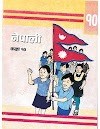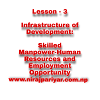ads
Class 10 Social Guide lesson-3 (Concept of Regional Development and Federalism)
Niraj Pariyar
February 26, 2023
2. What is federalism?
Ans:- The division of a country into various autonomous states and separation of power between a central authority and constituent political units is called federalism.
3. Differentiate between the unitary system and federal system in a sentence.
Ans:- In the unitary system there is only one government who rule over all the country whereas in a federal system the power of central government is shared by state government.
4. Define federal democratic Republican state.
Ans:- A state which is divided into federal and provincial governments, ruled by peoples elected head of government and state and democratic system of Governance is called the federal democratic republican state.
B. Short answer questions:-
1. What can be the basis for the division of a country in federal structure? Give a short introduction to each of them.
Ans:- The bases for division of the country in federal structure are listed and described below:
a) Language:- Language can be the base for the division of a country because when we divide it by the name of language, the language of the local people can be saved but it should be multilingual because our society is formed with multi -language.
b) Topography:- Topography can be another base for the division of a country into various states. The country is divided according to the land structure. So that every region will get divided equally without and topography problem.
c) Ethnicity:- Ethnicity is another base for the division of the country. Country is divided considering different ethnic group. Certain ethnic group people are divided into particular province.
d) Natural resources:- natural resources are also the base for division. Every province is divided by providing equal natural resources. In case if natural resources are not given of same. Then natural resources of the same value are provided, so any conflict occurs in the name of natural resources.
2. What are the dimensions of development?
Ans:- The dimensions of development are listed below:
i. Poverty alleviation
ii. Utilization of social norms and beliefs.
iii. Self-respect
iv. Increase in productivity
v. Fulfillment of basic needs
vi. Economic cultural and social progress
vii. Freedom and equality
viii . Modern thought.
3. What are the matters considered in order to establish the federal structure in Nepal?
Ans:- The matters considered in order to establish federal structure in Nepal are listed below:-
i. Establishment of peace and security in country
ii. Proportionate development in Nepal
iii. Eradication of social discrimination and raising awareness
iv. People's participation and suitable infrastructure development in provinces
4. Analyze the positive aspects of federalism.
Ans:- The positive aspects of federalism are analyzed below:
i. Maintains close relation between the state and its people
ii. It helps in maximum use of means and resources
iii. It has to increase public participation in development activities.
iv. It helps to settle the disputes at local level and maintain peace and security
v. It also helps to conserve the art, culture and heritage of the nation
5. "Federalism has negative aspects too". Justify this statement.
Ans:- Yes, the given statement is absolutely true that federalism has negative aspects too. As we all know that federalism is a division of country e into various autonomous states and division of power between Central government and provincial or state government. It has both positive and negative effect on the nation.
Following points will justify the above statement clearly:
i. Unequal distribution of means and resources between states may cause unequal development and misunderstanding among states.
ii. There may be misunderstanding between the federal government and provincial government regarding the share of power and authorities.
iii. The Federal system of government is more expensive.
iv. There may be a conflict between the states regarding the use of natural resources of border areas.
So, we can conclude that the federalism has negative aspects too.
6. What do the central, provincial and local level and people have to do for successful implementation of the federal system in the country? Present their roles.
Ans:- The role of the central, provincial and local level and people for successful implementation of the federal system in the country are mentioned below:
Central level government:-
i. Protection of national unity and territorial integrity.
ii. Managing and controlling Central level works and projects.
iii. Maintaining diplomatic relation and controlling state affairs.
iv. Looking over the works of the state government.
TikTok
Paid विज्ञापन
Followers
Follow On Facebook
Labels
About us
Keep visiting Coming Back for More With Engaging And Relevant content Name: Niraj Pariyar Class:11 contact: neerajpariyar222@gmail.com
Subscribe Us
Ad Space
Popular Posts
भर्खरको पोस्ट
4/random/post-list
ads
Popular Posts
.gif)
Unit-3 Lesson - 2 Folk Songs of Nepal
March 18, 2022

class 10- पाठ १ जन्मभूमि अभ्यास
January 30, 2022
Menu Footer Widget
Created By NirajPariyar | Distributed By Niraj Pariyar


.gif)


.png)
.png)





0 Comments